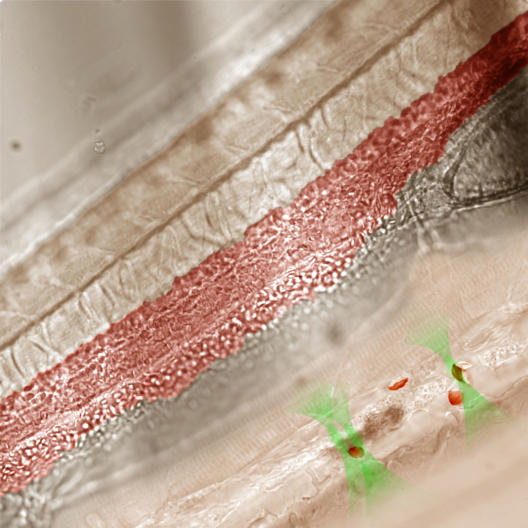Biology and Physics – Through CiM, these two disciplines grow closer together

Robert Meißner, PhD student in physics, and Wade Sugden, PhD student in biology, met at an event hosted by the Cells-in-Motion Cluster of Excellence at the University of Münster. Robert Meißner told Wade Sugden about the possibilities of optical tweezers, immediately sparking his interest. With optical tweezers, you can capture and steer tiny objects like red blood cells in living organisms just by using light, completely contact-free and without disrupting any surfaces. Wade Sugden, who is from Max Planck Institute for Molecular Biomedicine, was impressed. With that meeting both junior scientists started to work as a team.
Ever since, Robert Meißner and Wade Sugden have been in pursuit of one scientific question: what impact does the geometry of vessels have on cells? In zebrafish embryos, they study which forces work on veins and arteries. Because these forces also affect blood cells travelling within the vessels, they also investigate the elastic properties of the blood cells. To get quantitative results on that, the young scientists need to capture red blood cells in the blood flow with optical tweezers and measure exactly how strong the forces and elasticity are. The idea behind this research is that the viscoelasticity of cells has a direct impact on cellular processes, and vice versa. In addition, sick or damaged cells change their viscoelasticity. Thus, Robert Meißner and Wade Sugden want to clarify the precise intensity of the forces and the viscoelasticity.
The Cluster of Excellence supports these two scientists through the so-called pilot project programme, which supports small discrete research projects carried out by young scientists. These projects get financial support under one condition: the project partners must be from different disciplines and work together on one topic. Both junior scientists benefit from this support and are happy to work in an interdisciplinary way. “We discuss scientific questions together, talk about specific demands for the technology and search for solutions”, says Robert Meißner. With partnerships like that, both disciplines grow even closer together.
Their pilot project is already a success. Master student Sina Geiger, who works with both scientists, supplemented the optical tweezers with a technical setup that enables it to determine the viscoelasticity of blood within vessels. She recently received an award for her setup at the annual conference of The German Branch of the European Optical Society in Brno, Czech Republic.

